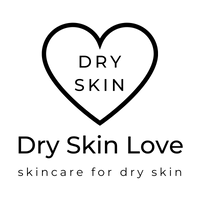The medical term for dry skin is xerosis cutis.
'Dry skin' is skin that is lacking water, humectants and fats.
Humectants absorb and hold water, while fats coat the skin and seal in moisture.
When there is not enough water, humectants or fats, skin barrier disruption can occur, further worsening symptoms of dry skin.
Dry skin appears dry, rough, and may scale and flake.
Dry skin may also show premature signs of aging, like fine lines, surface wrinkles and loss of elasticity.
This article will discuss:- What are symptoms of dry skin?
- Medical definitions of dry skin
- What causes dry skin?
- What is your skin barrier?
- Is dry skin due to a lack of water?
- Is dry skin due to a lack of fat?
- Is dry skin due to a lack of water and fat?
- Summary - what is dry skin?
- References
Do you have dry skin?
Dry Skin Love Apple Elixir 5% Vitamin E Face Oil is a special treat for dry skin, especially during winter.
This protecting face oil is made with 8 types of natural vitamin E - including natural tocopherols and rare tocotrienols.
It nourishes and protects your skin against the harsh elements.

What are symptoms of dry skin?
Dry skin is uncomfortable - it is overly tight, dehydrated, rough, and may flake and itch. Dry skin is a seemingly simple condition that has a wide spectrum of symptoms - from mild dryness and flaking to severe itching, redness and pain.
Symptoms of dry skin include:
- Loss of skin elasticity
- Skin feels tight, dehydrated
- Skin appears dull, rough and blotchy
- Slight to severe flaking, scaling or peeling
- Fine lines and wrinkles are more pronounced
- May have irritation and a burning sensation
- May have itching
Medical definitions of dry skin
The medical term for dry skin is xerosis cutis.
It originates from the Greek word ‘xero’ meaning ‘dry’, and ‘osis’ meaning ‘disease’ or ‘medical disorder’. The word 'cutis' means the true skin or dermis.
The medical definition of xerosis is abnormal dryness of a body part or tissue (as the skin or conjunctiva) (Merriam-Webster Medical Dictionary).
The International Classification of Disease (ICD-11 ED54) defines xerosis cutis as “dryness of the skin surface commonly due to defatting of the epidermis by excessive exposure to soaps and detergents or desiccation from prolonged exposure to low ambient humidity. It occurs most commonly in the elderly and is seen particularly on the lower legs. It is a major cause of pruritus in the elderly. In more severe cases the skin may become inflamed (asteatotic eczema).”
The US National Library of Medicine's definition of xerosis states "dry skin occurs when your skin loses too much water and oil" (MedlinePlus Medical Encyclopedia).
Or more simply, as the American Academy of Dermatology states "when skin loses too much water, it becomes dry."

What causes dry skin?
Dry skin is very common and can occur for a variety of reasons. You may have naturally dry skin. But even if your skin type is normal or oily, you can still develop dry skin from time to time. Dry skin can affect any part of your body.
Dry skin can be caused or worsened by:
- Exposure to cold weather
- Low humidity levels
- UV radiation and sunlight
- Harsh soaps or detergents
- Swimming in chlorinated pools
- Long and hot showers or baths
- Aging
- Menopause
Read more: What Causes Dry Skin?

What is your skin barrier?
Your skin barrier protects you from physical, chemical, and microbial insults, and prevents the loss of water from your body.
The skin barrier includes the outermost layers of skin, called the stratum corneum.
Your skin barrier is essentially what you can see and touch on the surface of your body.
When your skin barrier is healthy, it feels and appears smooth, soft, and plump.
In contrast, a damaged skin barrier looks dry, rough, dull, and dehydrated, and may become irritated and inflamed.
The stratum corneum can be thought of as a brick wall that protects you.
The "bricks" are the skin cells, called corneocytes, and the "mortar" that holds the bricks together is the lipids or fats, that together create the outer barrier.
Learn More: What is The Skin Barrier?

Is dry skin due to a lack of water?
"Dry skin is a common condition that is attributed to a lack of water in the stratum corneum" (Proksch et al, 2020).
Water is absolutely essential for the normal functioning of the skin.
-
Natural moisturizing factors (NMFs) and other humectants (such as glycerin and hyaluronic acid) to attract and hold onto moisture.
-
Intercellular lipids (fats) that form a barrier to prevent transepidermal water loss (TEWL) (Verdier-Sévrain et al, 2007).
Is dry skin due to a lack of fat?
The surface of your skin is covered by a layer of protective lipids (fats), including epidermal lipids and sebum.
Epidermal lipids are released from keratinocytes (skin cells), and are a mixture of ceramides, free fatty acids and cholesterol. These lipids are released from skin cells and fill the spaces between the cells, like mortar or cement (Pappas, 2007).
Sebum is an oily, waxy substance produced by your body’s sebaceous glands and eventually released to the surface of the skin. Sebum is primarily made up of non polar lipids as triglycerides, wax esters and squalene. Sebum coats the skin, seals in moisture, and protects your skin from getting too dry (Pappas, 2009).
Learn more: Beneficial Fats Found Naturally in The Skin Barrier

Is dry skin due to a lack of water and fat?
A more complete definition of dry skin is provided by Kresken et al:
Xerosis cutis is defined as skin deficient in hydrolipids. The condition is characterized by decreased quantity and/ or quality of lipids and/or hydrophilic substances (the latter is referred to as natural moisturizing factor) (Kresken et al, 2009; Augustin et al, 2019a).
This definition is interesting because it includes both lipids and water substances.
As we have seen, many definitions describe dry skin as skin deficient in water or skin deficient in fat.
In order to treat dry skin, you must consider both.

Summary - what is dry skin?
Dry skin is a bit more complicated than it first appears.
The medical term for dry skin is xerosis cutis.
- Dry skin has a lack of water.
- Dry skin has a lack of water-holding substances called humectants (glycerin, hyaluronic acid, natural moisturizing factors).
- Dry skin has a lack of epidermal lipids (ceramides, fatty acids, cholesterol).
- Dry skin has a lack of sebum (triglycerides, wax esters, squalene).
Dry skin is skin that is lacking water, humectants and fats. Humectants absorb and hold water, while fats coat the skin and seal in moisture. When there is not enough water, humectants or fats, skin barrier disruption can occur, further worsening symptoms of dry skin.
Dry skin is often relieved with the use of moisturizers, a good face oil, and some lifestyle modifications, such as using a humidifier, avoiding harsh cleansers, and supplementing the diet with essential fatty acids.
References
Augustin, Matthias, Dagmar Wilsmann‐Theis, Andreas Körber, Martina Kerscher, Götz Itschert, Michaela Dippel, and Petra Staubach. 2019a. Diagnosis and treatment of xerosis cutis – a position paper. JDDG: Journal der Deutschen Dermatologischen Gesellschaft 17 (S7): 3–33.
Augustin M, Kirsten N, Körber A, Wilsmann-Theis D, Itschert G, Staubach-Renz P, Maul JT, Zander N. Prevalence, predictors and comorbidity of dry skin in the general population. J Eur Acad Dermatol Venereol. 2019b. Jan;33(1):147-150.
American Academy of Dermatology website. Dry skin: Overview. www.aad.org/public/diseases/a-z/dry-skin-overview. Accessed September 10, 2021.
Bennett, James. 2021. Helena Rubinstein (1915-1930). Cosmetics and Skin (blog). Accessed September 10, 2021. https://www.cosmeticsandskin.com/companies/helena-rubinstein-1915.php.
Caspers PJ, Lucassen GW, Puppels GJ. Combined in vivo confocal Raman spectroscopy and confocal microscopy of human skin. Biophys J 2003 July; 85: 572-80.
ICD-11.online — International Classification of Diseases, Eleven Revision. Online edition of 2025.
Kresken J, Daniels R, Arens-Corell M. Leitlinie der GD. Gesellschaft für Dermopharmazie e.V.: Dermokosmetika zur Reinigung und Pflege trockener Haut. Gesellschaft für Dermopharmazie e.V., 30. April 2009.
Leveque JL, Grove G, de Rigal J, Corcuff P, Kligman AM, Saint Leger D. Biophysical characterization of dry facial skin. J. Soc. Cosmet. Chem., 82, 171-177 (May/June 1987).
Pappas A. Epidermal surface lipids. Dermatoendocrinol. 2009 Mar;1(2):72-6.
Piérard GE What do you mean by dry skin? Dermatologica. 1989;179(1):1-2.
Pons-Guiraud A. Dry skin in dermatology: a complex physiopathology. J Eur Acad Dermatol Venereol. 2007 Sep;21 Suppl 2:1-4.
Proksch E, Berardesca E, Misery L, Engblom J, Bouwstra J. Dry skin management: practical approach in light of latest research on skin structure and function. J Dermatolog Treat. 2020 Nov;31(7):716-722.
Verdier-Sévrain S, Bonté F. Skin hydration: a review on its molecular mechanisms. J Cosmet Dermatol. 2007 Jun;6(2):75-82.
Warner RR, Myers MC, Taylor DA. Electron probe analysis of human skin: determination of the water concentration profile. J Invest Dermatol 1988; 90: 218–24.
Xerosis Medical Definition | Merriam-Webster Medical Dictionary
Youn, Sang Woong. 2016. "Cosmetic Facial Skin Type." In Measuring the Skin, edited by Philippe Humbert, Howard Maibach, Ferial Fanian, and Pierre Agache, 1–6. Cham: Springer International Publishing.
Author Information

Dr. Natasha Ryz is the founder of Dry Skin Love Skincare. With over 10 years of experience as a formulator and a strong scientific foundation, Dr. Ryz creates products that combine the best of nature and science for transformative results.
She trained in Organic Skincare Formulation at Formula Botanica and took the Skincare Specialist Program at the School of Natural Skincare, with over 200 hours of specialized education. Dr. Ryz also holds a diploma in Beauty Brand Business Management.
Dr. Ryz’s scientific background includes a PhD in Experimental Medicine from the University of British Columbia, and she has over 15 years of research experience in microbiology, immunology, and biochemistry. This expertise informs every product she formulates, ensuring exceptional quality, efficacy, and luxury.
Email: natasha.ryz@dryskinlove.com




